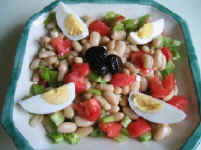Today we made, for the second time, a successful and fragrant batch of Persian brown rice! We owe our success to two sources: Mira Efrati’s new book Tasty from Nature, and our inspiring visit to the fantastic spice store in Beit Lechem HaGlilit this afternoon. I urge all Israeli readers to head there when they can and buy some lovely blends; there are delectable and unique herbal tea blends and some wonderful mixtures for rice, soup, and other yummy foods.
Mira Efrati’s book, which aims at providing macrobiotic foods, actually makes great strides toward making healthy food palatable; to be honest, it does so at the expense of health, and includes sugar (albeit brown) in many of its sweet recipes. I think it would be particularly useful for people making the transition to healthy whole foods who don’t have a lot of experience cooking. It does, however, offer fabulous tips on how to make a basic sourdough and yeast whole grain bread, and on how to make various types of rice based on a basic Persian recipe.
We modified the recipe a bit, so that the rice wouldn’t burn the bottom of the pot, and used one of the delicious spice blends; this one included, in addition to a variety of “red” spices which gave the rice a wonderful reddish hue, onions, pine nuts and pecans. But I bet you could use the basic recipe with any spice mix you have. Here goes.
2 cups long grain brown rice
lots of water for stage 1
1 cup water for stage 2 (possibly a bit more)
a pinch of salt
2 tbsps olive oil
5 tbsps dry spice mix
Rinse rice in water several times, then place in pot with tons of water and salt. Cook for about 10-15 minutes, or until rice is barely chewable but not ready yet. Drain rice into a collander.
Then, coat bottom of pot with olive oil. Layer half the rice on top, then layer spice mix and other half of rice. Make a “hole” in the rice hill, so steam can escape. Drizzle about 3/4 cup water on top.
Place a towel on top of the pot, then place the lid. Cook for about 15 minutes, then check if water has evaporated; if rice is still dry, add the rest of the water. Cook until soft and fragrant. Yum!






